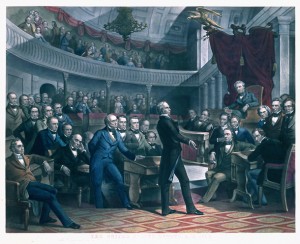CongressionalGlossary.com, from TheCapitol.Net
Amendments to a measure in the Senate can be offered at almost any time while the measure is under consideration. In addition, an amendment can be debated for an unlimited amount of time. In most cases, an amendment can relate to any subject, even if it is unrelated to the measure that is actually being amended.

Whenever a measure is under consideration on the floor of the Senate, committee amendments are always considered first. The Senate typically agrees by unanimous consent to committee amendments as part of a package. These are known as en bloc amendments.
Amendments may be printed or unprinted. Printed amendments are offered in advance of floor consideration of a measure and they are printed in the Congressional Record. While a bill’s sponsor will typically call up his own amendment, it is possible for any senator to call up a printed amendment. Unprinted amendments are not available in advance. They may be drafted on the floor while the measure is being considered.
Usually, Senate amendments do not need to be relevant, or germane, to the measure. Amendments that are non-relevant are referred to as riders. Measures may contain several non-relevant amendments. These are often referred to as Christmas-tree bills.
Relevancy is necessary for general appropriations bills. These include bills on which cloture has been invoked as well as concurrent budget resolutions and measures that are regulated by unanimous consent time agreements.
An amendment may also be classified as either a first degree or second degree amendment. A first degree amendment changes the text of the measure that is under consideration. A second degree amendment proposes changes to the text of a first degree amendment.
There can also be perfecting amendments and substitute amendments. Perfecting amendments modify or change language. Substitute amendments add new language to existing text. A perfecting amendment is considered to be a second degree amendment, and they are always voted on prior to substitute amendments.
A motion to table is often used in order to avoid voting directly on an amendment. Table refers to killing a provision. Any Senator may choose to make a motion to table that is non-debatable. A Senator may announce that they will offer a motion to table an amendment but will not actually do so until debate has taken place. By agreeing to a motion to table, the Senate will not vote directly on the amendment and as a result will avoid having to vote against it.
To learn more about the amendment process, consider signing up for TheCapitol.Net’s 3-day workshop Advanced Legislative Strategies.
Courses
- Congressional Operations Briefing – Capitol Hill Workshop
- Congressional Dynamics and the Legislative Process
- Drafting Federal Legislation and Amendments
- Understanding Congressional Budgeting and Appropriations
- Advanced Legislative Procedure
Publications
CongressionalGlossary.com, from TheCapitol.Net
For more than 40 years, TheCapitol.Net and its predecessor, Congressional Quarterly Executive Conferences, have been teaching professionals from government, military, business, and NGOs about the dynamics and operations of the legislative and executive branches and how to work with them.
Our custom on-site and online training, publications, and audio courses include congressional operations, legislative and budget process, communication and advocacy, media and public relations, testifying before Congress, research skills, legislative drafting, critical thinking and writing, and more.
TheCapitol.Net is on the GSA Schedule, MAS, for custom on-site and online training. GSA Contract GS02F0192X
TheCapitol.Net is now owned by the Sunwater Institute.
Teaching how Washington and Congress work ™

